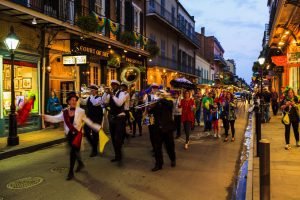Faubourg Marigny, directly across Esplanade Avenue from the French Quarter, and Bywater, right next door, are two of the most colorful neighborhoods in the city. The architectural styles borrow heavily from the colonial French and Spanish and have elements of the Caribbean. This blending over the last three centuries has resulted in an architectural style unique to the city of New Orleans.
Faubourg Marigny
Formerly part of a plantation, this area was developed by Creole landowner Bernard de Marigny, beginning in the early 19th century. He divided his plantation and sold the lots in an 1806 subdivision, the Faubourg Marigny. They sold so quickly that he extended the development four years later.
Sales of the affordable, modest-sized lots were spurred in 1831 when the Pontchartrain Railroad, or “Smoky Mary,” began running on Elysian Fields Avenue. Smoky Mary is now a very popular, spectacular, recurring Mardi Gras float of several sections in Harry Connick Jr’s Orpheus Parade which rolls on Monday night before Fat Tuesday.
In the early 19th century, the New Marigny was where white Creole gentlemen set up households for their mistresses of color (and their offspring) in the tradition of “plaçage” an extra-legal system practiced widely in New Orleans.
This neighborhood was settled primarily by Louisiana Creoles of color and German immigrants between the 1830s and 1880s.
Several musicians like Ferdinand LaMothe, better known as Jelly Roll Morton, Sidney Bechet, Manny Perez, Danny Barker, and Paul Barbarin, all giants of New Orleans music, made their homes in the neighborhood.
Frenchmen Street developed one of the city’s premier locations for live music venues and restaurants and is a destination for music devotees. The neighborhood is also home to the New Orleans Center for Creative Arts riverfront facility.
The Faubourg Marigny is one of the city’s most colorful neighborhoods; the architecture borrows heavily from the colonial French and Spanish and has elements of the Caribbean. This blending of cultures over time has resulted in a unique architectural style.
It has the air of what the French Quarter was a generation or two ago before there was so much tourist development. It has a few small hotels and many bed-and-breakfasts, as well as a number of good restaurants, coffee shops, and music venues. Part of the city’s old high ground, it fortunately escaped the worst of the post-Katrina disaster.
The Bywater
This is the next neighborhood over from the Marigny across Elysian Fields Avenue. The area was mostly plantation land and became an important residential development at the start of the 19th century.

Elizabeth’s Restaurant
Many people from France, Spain, and the French Caribbean settled here. During the century, it grew with both white Creoles of French and Spanish descent, as well as mixed-race Creoles of French, Spanish, African, and Native American descent. They were also joined by immigrants from Germany, Italy, and Ireland.
Bywater is home to the site at which Homer Plessy was removed from an East Louisiana Railroad car for violating the separate car act, an event that resulted in the Plessy v. Ferguson case and the legal doctrine of “separate but equal.” Today, a historical marker stands at the intersection of Press Street and Royal Street to commemorate the event.
By the late 1990s the bohemian, artistic type of communities such as were found in the French Quarter mid-20th century had spread to Bywater, and many long-neglected 19th-century houses began to be refurbished. Today there are several international celebrities who choose to make their homes here: Singer/songwriter/producer Ani DiFranco, and Dave Pirner of the 1990s Grunge band Soul Asylum
This area is full of wonderful restaurants, most notably Elizabeth’s, an excellent place for breakfast. Bars and clubs are in abundance here as well.
Looking for a place to stay, you’ll find offerings listed for Marigny/Bywater since they are considered one big neighborhood each with unique characteristics.




